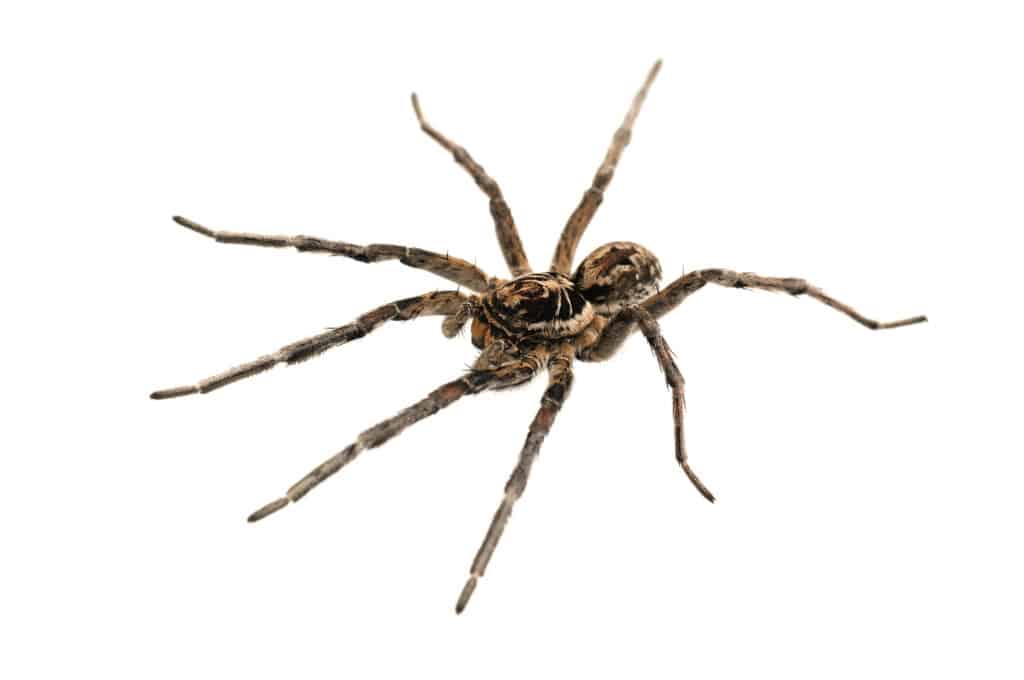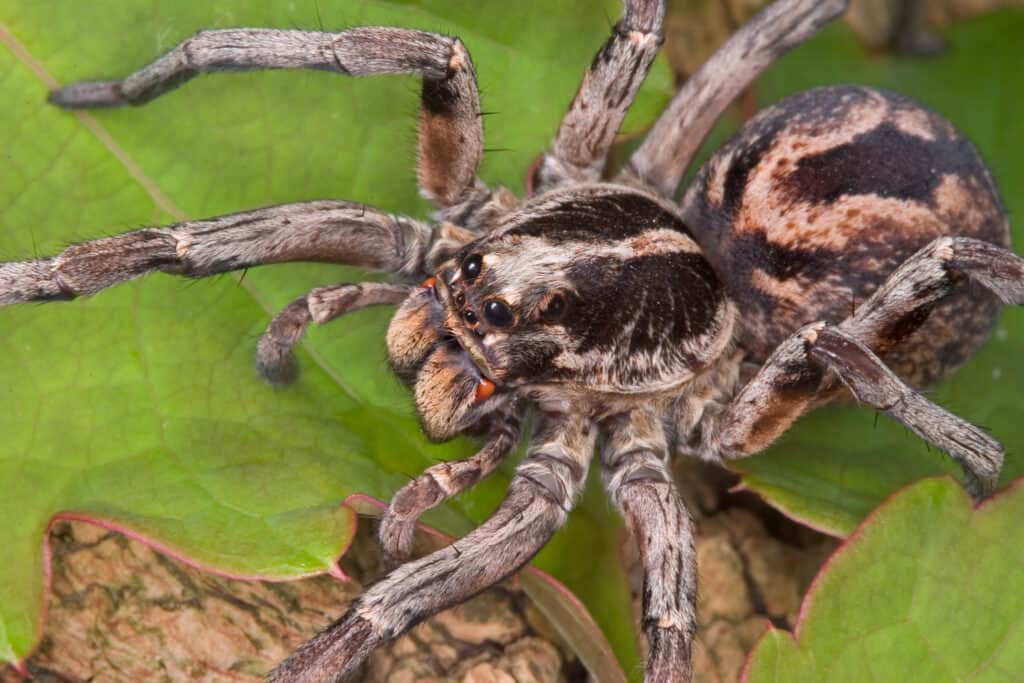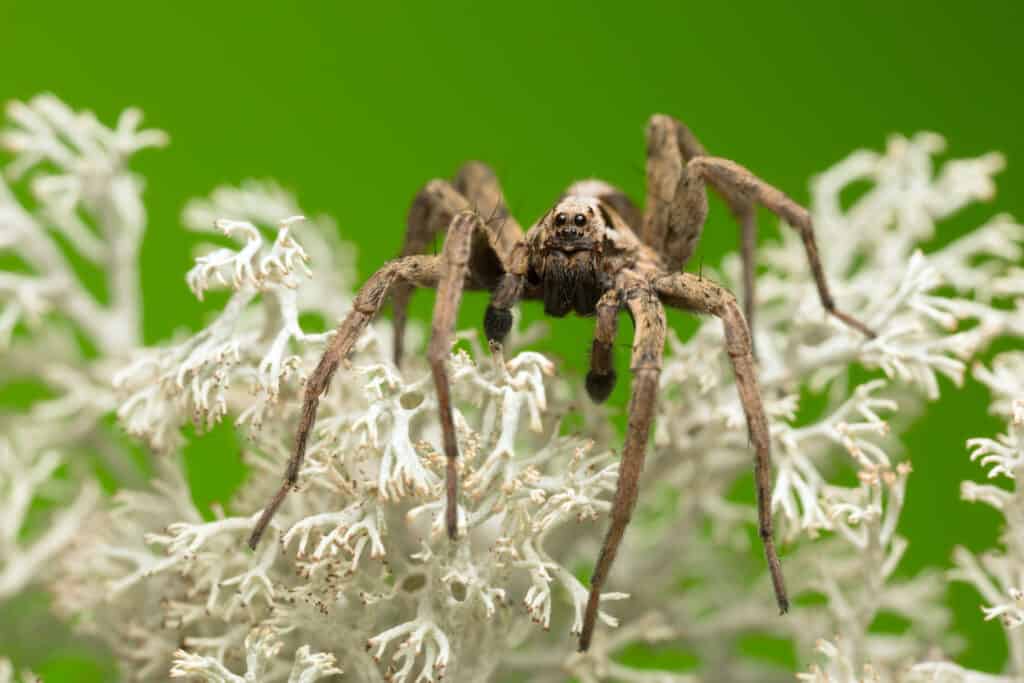Spiders are intrinsically interesting to some people and terrifying to others. The biggest spiders tend to be the ones that garner the most attention and fear from humans. Wolf spiders are among the largest spiders that you can find in most parts of the United States, so most people don’t want to get too close to them. However, for people interested in spiders and sexual dimorphism, you may want to know the differences between a female wolf spider and a male wolf spider.
That’s precisely what we’re going to show you today. Come learn five different ways to tell a male wolf spider from a female wolf spider.
Comparing a Female Wolf Spider and a Male Wolf Spider

Female Wolf-spiders are seen carrying the egg sac close to their abdomen before the eggs hatch.
©Henrik Larsson/Shutterstock.com
| Female Wolf Spider | Male Wolf Spider | |
|---|---|---|
| Size | – 3/8 to 1 3/8- inch body size – Up to 2-4 inches in legspan | – 1/4 to 3/4 inch body – Smaller legspan, but can still reach over 2 inches in length |
| Pedipalps Size | – Small pedipalps that are not swollen due to the lack of sperm present | – Swollen pedipalps – Pedipalps are used to store sperm and then transfer sperm to females |
| Presence of Young | – Will carry egg sac below on their abdomen – Carries dozens or hundreds of their young on their backs once they’ve hatched | – Does not carry their young around in an egg sac – Does not carry their young on their backs |
| Epigynum | – Has an external genital structure on the ventral abdomen – The organ receives the male palpal organs during reproduction | – Lack an epigynum |
| Lifespan | – Between 2 and 3 years – May have longevity impacted by laying eggs | – 1 year or less – Male spiders die soon after reproducing; sometimes they are devoured in the act |
The 5 Key Differences Between a Female Wolf Spider vs. Male Wolf Spider
The greatest differences between a female wolf spider and a male wolf spider can be found in their body size and interaction with spiderlings. Female wolf spiders are far larger than male wolf spiders, with an average body size that measures up to 1 3/8 inches compared to males that have a body size that only reaches about 3/4 inch body size.
Furthermore, female wolf spiders interact with spider eggs and spiderlings, while males do not. Females are seen carrying the egg sac close to their abdomen before the eggs hatch and carrying dozens or hundreds of baby wolf spiders on their backs when they’re born.
These are two major differences that help quickly identify male and female wolf spiders, but they are not the only differences. Let’s take a closer look at other features of male and female wolf spiders to better understand what makes them unique!
Female Wolf Spider vs. Male Wolf Spider: Size

The average male wolf spider measures between 1/4 inch and 3/4 inch in total body size, and has a legspan that reaches about 2 inches in length.
©D. Kucharski K. Kucharska/Shutterstock.com
Female wolf spiders have larger bodies than male wolf spiders, and they have larger leg spans as well. The average male wolf spider only measures between 1/4 inch and 3/4 inch in total body size while having a legspan that reaches about 2 inches in length.
Meanwhile, the female wolf spider has a body size that can measure 1 3/8 inches with a legspan of 2 to 4 inches in some of the largest species, like the Carolina wolf spider. So, if you see an absolute monster of a wolf spider, the chances are better that it’s a female rather than a male.
Female Wolf Spider vs. Male Wolf Spider: Pedipalps Size
Male wolf spiders have larger pedipalps than females. Pedipalps appear like two small legs near the spider’s head that are used to grasp prey but are also used during reproduction. Mature males ready to mate will have enlarged pedipalps filled with sperm, and females will not have enlarged pedipalps.
As a result, if you can get a very close look at a wolf spider, it’s possible to differentiate the sexes based on that alone.
Female Wolf Spider vs. Male Wolf Spider: Epigynum

The epigynum is a structure on the ventral abdomen of female wolf spiders that receives sperm during the act of reproduction.
©Cathy Keifer/Shutterstock.com
Female wolf spiders have an epigynum, while males lack one. The epigynum is a structure on the ventral abdomen of female wolf spiders that receives sperm during the act of reproduction. This hardened plate on the bottom of the female is not present on the male.
If you have a female wolf spider in a container that allows you to view the spider’s underside, then it’s possible to see this structure and determine the sex of a wolf spider with ease.
Female Wolf Spider vs. Male Wolf Spider: Care of Spiderlings
Female wolf spiders are responsible for caring for the species’ young, but male spiders do not take up that task. The female wolf spider will spin an egg sac containing dozens or hundreds of eggs, carrying that sac on its abdomen until the eggs hatch. Once spiderlings emerge, the mother spider will carry her young on her back for several days.
This mass of spiderlings on her back can make the female wolf spider appear even larger! The same cannot be said of male spiders, so this is a quick way to tell the two creatures apart.
Female Wolf Spider vs. Male Wolf Spider: Lifespan

Male wolf spiders only survive for about a year or less.
©Henrik Larsson/Shutterstock.com
Female wolf spiders live longer than male wolf spiders. Although this fact cannot be used to differentiate them in the wild, it is still useful for knowing what makes each sex different. Female wolf spiders can live for several years, and they’re capable of surviving for between 2 and 3 years. Their longevity is affected by breeding, though.
Males only survive for about a year or less. Their smaller size makes them vulnerable, but many die during the breeding process. Wolf spiders practice sexual cannibalism, meaning that they may be devoured by their partner soon after copulation!
As you can see, several methods exist for telling a male wolf spider from a female wolf spider. Your best bet is to look at their size and for the presence of baby spiders. If you can get close to the spiders, you can consider their pedipalps and epigynum to determine if they are male or female. This can be useful for people studying wolf spiders or keeping one as a pet!
Up Next:
- 10 Incredible Wolf Spider Facts
- What Do Wolf Spiders Eat?
- Are Wolf Spiders Poisonous or Dangerous?
- Wolf Spider vs Tarantula: What Are the Differences?
The photo featured at the top of this post is ©
Sources
- JSTOR, Available here: https://www.jstor.org/stable/3705951
- Science Direct, Available here: https://www.sciencedirect.com/science/article/abs/pii/S0003347204003495
- MISSOURI DEPARTMENT OF CONSERVATION, Available here: https://mdc.mo.gov/discover-nature/field-guide/wolf-spiders
Thank you for reading! Have some feedback for us? Contact the AZ Animals editorial team.






